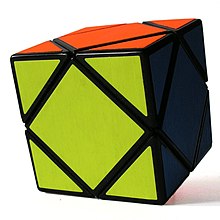Skewb


The Skewb (/ˈskjuːb/) is a combination puzzle and a mechanical puzzle in the style of the Rubik's Cube. It was invented by Tony Durham and marketed by Uwe Mèffert.[1] Although it is cubical in shape, it differs from Rubik's construction in that its axes of rotation pass through the corners of the cube rather than the centres of the faces. There are 8 such axes, one for each space diagonal of the cube. As a result, it is a deep-cut puzzle in which each twist affects all six faces.
Mèffert's original name for this puzzle was the Pyraminx Cube, to emphasize that it was part of a series including his first tetrahedral puzzle, the Pyraminx. The catchier name Skewb was coined by Douglas Hofstadter in his Metamagical Themas column. Mèffert liked the new name enough to apply it to the Pyraminx Cube, and also named some of his other puzzles after it, such as the Skewb Diamond.[2]
Higher-order Skewbs, named Master Skewb and Elite Skewb, have also been made.[3][4]
In December 2013, Skewb was recognized as an official World Cube Association competition event.[5]
Mechanism[]
This section's tone or style may not reflect the encyclopedic tone used on Wikipedia. (April 2021) |
Despite a simple appearance, its pieces are actually divided into subgroups and have restrictions that are apparent upon examining the puzzle's mechanism. The eight corners are split into two groups—the four corners attached to the central four-armed spider and the four "floating" corners that can be removed from the mechanism easily. These corners cannot be interchanged i.e. in a single group of four corners, their relative positions are unchanged. They can be distinguished by applying pressure on the corner—if it squishes down a bit, it's a floating corner. The centers only have two possible orientations—this becomes apparent either by scrambling a Skewb-alike puzzle where the center orientation is visible (such as the Skewb Diamond or Skewb Ultimate), or by disassembling the puzzle.
Records[]
The world record time for a Skewb is 0.93 seconds, set by Andrew Huang of Australia on 12 July 2019 at WCA World Championship 2019 in Melbourne, Australia.[6]
The world record average of 5 (excluding fastest and slowest) is 1.86 seconds, set by Carter Kucala of the United States on 4 December 2021 at Cubetcha A 2021 in Brooklyn Park, Minnesota, with the times of 2.02, 1.32, 1.83, 3.29, and 1.73 seconds.[6]
Top 5 solvers by single solve[7][]
| Solver | Fastest solve | Competition |
|---|---|---|
| Andrew Huang | 0.93s | WCA World Championship 2019 |
| Leo Min-Bedford | 0.97s | Selangor Cube Open 2019 |
| Carter Kucala | 1.02s | Minnesota Cube Days 2020 |
| Daniel Vædele Egdal | 1.04s | Tårnby Cube Træf 2019 |
| Jonatan Kłosko | 1.10s | ŚLS Wodzisław Śląski 2015 |
Top 5 solvers by average of 5 solves[8][]
| Name | Fastest average | Competition |
|---|---|---|
| Carter Kucala | 1.86s | Cubetcha A 2021 |
| Łukasz Burliga | 2.03s | CFL Santa Claus Cube Race 2017 |
| Michał Rzewuski | 2.13s | III Masovian Open 2019 |
| Zayn Khanani | 2.17s | Utah Fall 2021 |
| Michał Krakowski | 2.23s | LLS VI 2018 |
See also[]
- Dino Cube
- Dogic
- Megaminx
- Pocket Cube
- Professor's Cube
- Pyraminx Diamond
- Pyraminx Duo
- Pyraminx
- Rubik's Revenge
- V-Cube 6
- V-Cube 7
- V-Cube 8
References[]
- ^ "Tony Durham Mechanical Puzzles". The Metagrobologist. Retrieved September 22, 2020.
- ^ "Jaap's Puzzle Page, Skewb Page". Jaap's Puzzle Page.
{{cite web}}: CS1 maint: url-status (link) - ^ Master Skewb
- ^ Elite Skewb
- ^ "Add Skewb. Resolves issue #102. · thewca/wca-regulations@66d6da9". GitHub. Retrieved 2021-01-26.
- ^ a b World Cube Association Official Results - Skewb
- ^ World Cube Association Official Skewb Ranking Single
- ^ World Cube Association Official Skewb Ranking Average
External links[]
- Birgit Nietsch's Skewb page
- Jaap's Skewb page
- Kirjava-Meep Skewb Method proposed by Thom Barlow and Kristopher De Asis.
- Sarah Strong's Skewb Method with variations for all skill levels.
- Rubik'skewb solution by Hideki Niina.
- Ranzha's Skewb Method by Brandon Harnish.
- Logic puzzles
- Mechanical puzzle cubes
